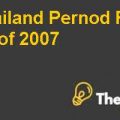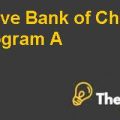
Gucci Group
Solution No.1
When Gucci found it difficult to achieve the sufficient amount of profit, they had made some changes in their strategy to restructure the business. They were unable to find new orders and collections due to low scale advertising and marketing activities. Gucci considered that reorganization is needed for the sake of the company’s interest. One of the main priorities while restructuring the firm was the cost cutting for the new hiring. Several people were fired at the corporate level for that purpose and the employees were entirely astonished in that situation.
Another main focus of the Gucci was to focus on fashion business, they felt that focusing on that segment was the right strategy for the company to achieve long term success. They targeted the fashion conscious customers and designed the policies accordingly. Gucci’s management also revised their price structure and lower the prices by 30 percent. The aim of the Gucci was to strengthen the brand that gives a positive message to the customer. Another component of the turnaround strategy was to develop the brand image to the customers. Gucci also improved their marketing strategy to convey the message to the customers in a more dignified way. At the initial stage, advertising expenditures increased significantly, but later on it resulted in a drastic increase in the revenues.
Solution No.2
Gucci’s go forward strategy is entirely based on product development because they want to add more products in the fashion industry. The aim of the Gucci is to become multi-brand company rather than single brand. This strategy is also implemented by other competitors as well, such as Louis Vuitton and Prada. Gucci Group added variety of products at a broader level for the purpose of product development. As a result of acquiring YSL Beaute and Sergio Rossi, Gucci now has to tackle several independent brands because each requires a unique communication and positioning strategy. Another long term strategy of Gucci is based on acquisitions and the vision of Gucci is to effectively manage the diversified product line.
Solution No.3
Strengths
- Strong brand image is one of the major strength of the company in both domestic and global levels.
- The company also has remarkable control over distribution channels.
- Directly Operated Stores (DOS) has increased significant market share.
- The group has more than ten brands.
- Focus on the fashion industry.
Weaknesses
- Management inconsistency may affect the strategy and vision of the organization.
- The financial position of the Gucci Group is weak.
- Several brands in the group are causing a significant amount of losses to the business.
Opportunities
- In the luxury markets, opportunities for the group is rapidly increasing due to growing economies across Asia, such as China and India.
- Gucci may add more products in the new markets in order to gain competitive advantage.
- The group has several business segments that may generate more revenues.
Threats
- Luxury goods, mostly purchased by the rich people.
- Various dominant players are operating in the market, including Louis Vuitton. Due to the strong brand image and financial position, Louis may increase its market share in the luxury brands.
- Advertising and promotional activities need sufficient amount of funds in the luxury markets to promote the brand and maintain the image.
- Threat of substitute is a major threat in the industry.
Solution No.4
The luxury goods industry is growing and it is a great opportunity for the competitors to participate in this sector. It was a $60 billion industry in the year 1999 and the sales also rapidly increased at a rate of 6 per cent. The industry included seven major products such as: leather goods, footwear, high-end apparel, watches, perfumes, cosmetics and jewelry. Luxury industry was an extremely profitable business, profit margins in the watches and leather goods were favorable for the industry.....................
This is just a sample partial case solution. Please place the order on the website to order your own originally done case solution
Considers turnover Gucci and his transition from one brand to a multi-brand company. Rewritten version of the previous case. "Hide
by David B. Yoffie, Mary Kwak Source: HBS Premier Case Collection 21 pages. Publication Date: September 19, 2000. Prod. #: 701037-PDF-ENG













